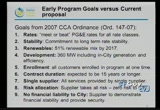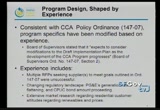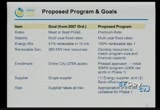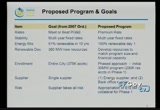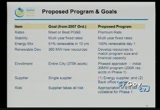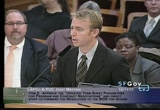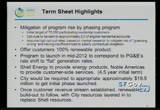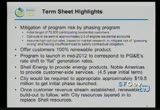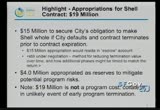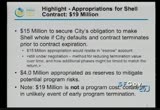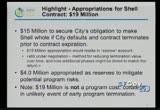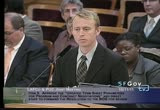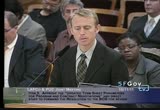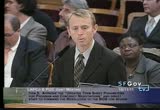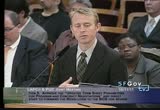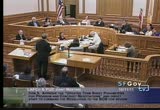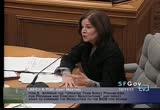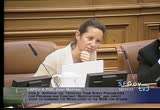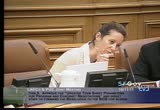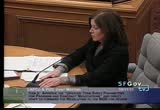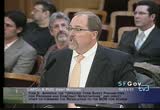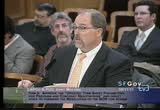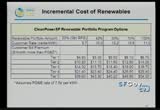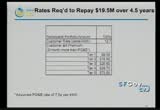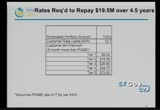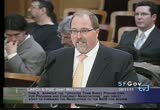tv [untitled] October 16, 2011 10:30am-11:00am PDT
10:30 am
mike campbell. thank you. >> thank you for the introduction, ms. miller. cfo riedstrom and i are going to sort of tag team this presentation. i will start out with an update in terms of where we are in our discussions with our counterparties and the way the program is being shaped based upon the analysis and the best way mitigating the risks before us that ms. miller highlighted. and the cfo will go through some of the financial impacts. i have an electronic presentation. just by way of a refresher, i wanted to highlight in, and i believe this was it touched on
10:31 am
by jerrick campos in terms of the 2007 ordinance, in past presentations, we noted how the program was shaping up and how it differs from the precise language from the 2007 ordinance but how it used to the general goals and objectives. this is a quick refresher, this slide goes to the various objectives that were in 2007 of having raids that meet or beat pg&e, having stability in those raids, a target of 51% with 360 megawatts of build-out and having all customers enrolled at once, a very long term contract, 15 years or longer with a senior supplier taking on 100% of the risk and there being zero liability to the city. as you well know, we have gone through several rfp's and have
10:32 am
had challenge is finding a single supplier willing to take on those risks. we have learned a lot about the program as we moved forward. and we had the expectations that things might change. a couple of the things i would like to highlight here from this slide, one being that the regulatory landscape continues to change. as was touched on by the previous speaker, ms. marshall, there has been the change from pg&e's rate structure from a tiered generation rate to one where rates remain constant regardless of customer usage on the residential side. that caused us to rethink some of the ways that we actually do rate design. as part of that, we have done some extensive market research on the residential side to really understand the expected participation rates at various price points. very detailed to -- a very
10:33 am
detailed questions to customers about their attitude towards renewable and how much per month customers would be willing to pay to have more renewals in their home. so this chart here on a slide five describes, in a summary level, how what we are bringing to you all, as in the proposed terms sheet that we are recommending you take -- that we bring to the board of supervisors for their consideration, how we compare the first thing, meet or beat. that is an extreme challenge. that would be a hard hurdle to get over, in large part because of pg&e's large portion of the portfolio that is fully depreciated. talking about hydro resources and also nuclear resources. we're looking at differentiating our product, providing it
10:34 am
renewable products of 100%. initially, getting to 51% was the objective. but charging our customers more than they would otherwise be paying from pg&e. in both cases, we do state to have seen the rate being known overtime and the rates will be changing from year to year, but we will be able to let our customers have the knowledge of what those rates would be. in utility bills, even as someone who has been in the energy regulatory regime in california for 10 years, it is it awfully hard to keep track of how pg&e's rates down the route. the enrollment strategy has changed. we're looking at not trying to get to all customers at once, that using a phasing approach. that has been successful in marin. we have been modeling and anticipating the program
10:35 am
starting at 30 megawatts and sitting notices out to about 230,000 residential accounts to get to that. i think that is the subject of some discussion. the other objective was to have a single supplier taking on all risk, and that is something we have not been able to find, find a supplier willing to do all of those tasks. it is a lot of risk for any one supplier to take on. there are strengths and weaknesses from various entities, and must entities that have the credit rating we need and are in the energy supply business are not necessarily in the back office tracking the customer business. so we're working with two different suppliers there. i just wanted to cover a few highlights of the term sheet that is before you for your consideration. supervisor avalos: just so i understand, we have the possibility of energy generators
10:36 am
that are not part of supplying directly to customers, they actually provide that to like pg&e or another into the that deals with the customer relationships? >> correct, pg&e has -- usually, pg&e is getting wholesale supplies, large blocks of energy, and they are playing -- paying for those directly by laterally with that supplier. they're dealing with who is using what energy on a customer bases. pg&e has the infrastructure. so we will have a third-party vendor handling some of that and helping us calculate the bills. supervisor avalos: the supplier does not have their relationships directly with the customer? >> it is less on the relationship with the customer, per se. it is more the software for handling the major usage data that comes in on a daily basis in terms of this customer used a certain amount of megawatt hours
10:37 am
of the previous interval time and the rate they're getting charged as this, therefore there bill should be this much. that is hundreds of thousands of transactions as opposed to one big transaction. supervisor avalos: thank you. >> so one of the risks that we talked about in the past but i think is important to notes is the challenge of we get one chance, by law, to have customers opt out. if they do not do anything, that is a good thing, but once they have opted out, we will have to entice them to come back in. that could be an uphill battle once people have made up their mind to not pay attention to their energy again. so we are looking at using market data in terms of targeting how we do our of reach. we expect that we would be targeting have been 75,000
10:38 am
participating accounts. that is for an average of demand of 30 megawatts. we have to get to about 75,000 participating accounts, and we will looking at sending out opt out notices to approximately two-thirds of all eligible residential accounts. we think that we're going to be very up front unclear about the benefits of the program in our marketing to customers -- very of friend and clear. we will let them know their bills will change. but we will let them know they will be getting a 100% renewable product. based on market research, we think it's significant number of folks in the city really want to put their money where their mouth is, and they're willing to pay more for renewable energy. the contract with shell would be a four and half year initial term. that gives us -- that balances out the desire to have the rates
10:39 am
be a noble into the future and have a stable rates. we're going to be putting forward a longer contract term which increases the amount of that. the amount that the city is being contemplated is in the term sheet and that we have been working with a shell about is to have $19.5 million of collateral. that is in a manner to -- that is an amount that will need to be appropriated before the contract can be final. we also think this was touched on in the previous speaker's remarks, that as we gained time in the market, as we demonstrate that we have customers and a revenue stream, that will help us be able to collateralize that revenue stream and begin to issue debt from the program to help programbuild new renewals.
10:40 am
we have had some really good discussions, several discussions in the past several weeks, with stakeholders and local power about different ideas and thoughts for enhancing the built-out, and we look forward to a contract very soon with local power for that. so i wanted to touch base and give it a little more detail into what is behind that collateral for you will. $19.5 million is the total amount of collateral we anticipate two $90 million for the contracts with shell. some of the outcome of to but not exceeding $500,000 for the contract with noble americas. 40 $19 million rishel, a $15 million is to secure the make shall secure that should
10:41 am
something happen, no fault of anyone. the customers did not materialize it. if the revenues to not cover our costs, that the program has to cease aberration before the full four and a half term that shell has some financial security. that is $15 million up front. that would be an escrow account so that all parties could see it. we would see that it has been put on in this escrow account. shell would be able to see that it is there and available. if there is an early termination, it would provide a counter signature from both parties sites to make sure the appropriate amount of funds are sent to the shell should they be old pavement. let me say what that means, should there be a payment due, there is the appropriation of the $19 million. it does not mean necessarily gets spent. this is really just collateral. so the program operates as we
10:42 am
expected well, and consistent with the pro forma, the 90 four and a half years, we would still have all of it. even if the programmer to terminate early, shell is not entitled automatically for the full $15 million. did the prices have fallen for whatever reason during that time, this is intended to help make shall be made whole for whatever losses. in addition to that -- commissioner torres: yes, the $19.5 million is going to be put into where? >> the $15 million would go into some of the escrow account. commissioner torres: the $19.5
10:43 am
million goes where? >> $15 million goes into an escrow account. another $4 million goods appropriated as reserves. one is in what we're calling a locks box account or customer revenues flow into and payments to shell and other entities flow out of it. commissioner torres: so the $15 million would come from where? >> that is part of what is in front of the body, the proposal, and the cfo. commissioner torres: does it come from the san francisco general fund, supervisors? >> it is more the sfpuc's funds. commissioner torres: the $15 million in the escrow account would be paid at what interest rate? u.s. treasury rate, at a bank right? >> i will let the cfo answer that question.
10:44 am
>> i am the general manager. the first concept is the $15 million is part of the $19 million. $15 million would go into an interest-bearing account. we have not decided where and what kind of return. commissioner torres: all right, what are the benchmarks? i do not recall having seen the benchmarks for what constitutes financially successful. >> the financial success of the program really is the concept that we are meeting the expectations of the pro forma and that the balance that the program is not going negative in terms of costs being higher than expected, more than, i believe, about $1.5 million. we have some money put in there to cover the unexpected. we're not thinking that we can
10:45 am
get everything 100% right. we might have our revenue targets be off by a little bit. so we have $2 million, built in there for that. but if it goes beyond that, it might be the time that we realized that, for whatever reason, the customers are not participating in the rate we expected, maybe we need to work with shell and the above reducing the size of the program or maybe it is time to discuss with everyone, especially the body, should we be terminating the program? commissioner torres: so it is if the program is not financially successful? >> correct. commissioner torres: if it is successful we do not want to continue it -- >> you are doing a great job helping me get to the next slide. commissioner torres: if we're going to reimburse shell for our default and the program is
10:46 am
successful while we are defaulting, how are we going to measure the losses? >> so -- commissioner torres: because they're not going to be capped. >> let me try to answer the question in two parts. the first one, where the program terminates because of -- in the instance i just talked about where the revenues are not matching expectations and we are in a citrus and reliability is to cap at $15 million. the calculation to figure out what is owed is the difference between where the market moved in with the contract price is. that could wind up with a number higher than $15 million. we think it is very unlikely. but it is conceivable. but the maximum that shell would be held with the $15 million.
10:47 am
the second scenario, the one that you were creating, the program is would -- working find that there could be political decisions that we do not want cca anymore, that is the uncapped scenario. the same arithmetic would apply, but there will be no cap. supervisor campos: don't they still have to show damages? rex that arithmetic shows there are damages. it would be an audible lost. it would show with a reply in energy for and what they wound up selling energy for the time we defaulted and that difference attended two is the lost. >> i was just going to say, if the program is successful, that means that your opt out rates are within your margin, you're selling your power, so the program is financially successful. the idea that if you terminated i think would be pretty small.
10:48 am
but even if you did, shell would be able to presumably felt that power into the market. so they would have to show damages that they were unable to sell its for the price they paid. it the program was successful, we already know that probably -- commissioner torres: i do not know the terms of the memorandum. it cannot be arbitrary or capricious in terms of our default. >> that is correct. the only reason why we are in this is because, as a public entity, you really cannot enter in appropriate money for longer than a year. so we have to have these kind of stopgap termination provisions in order to get someone to enter into a long- term contract with us. president vietor: i had a follow-up. so this money would be appropriated for a year, and then it would go back to the puc at that point? >> we actually would be
10:49 am
appropriating it for multiple years. president vietor: the term of the contract? four 1/2 years? >> it can continue on until taken away. the contract would require us to have the appropriation in place. allow us to decrease as the risk increases. president vietor: then if we meet our financial goals, then it would still be -- is there a benchmark time when it gets put back into the coffers? commissioner torres: it says 4.5 years. >> the appropriation and the funds sitting there in the escrow account to give shell comfort in the case of default, we are in discussions with shell about how that amount could decline over time it the remaining contract declines. again, to emphasize, just
10:50 am
because this money is appropriated and in that escrow account, it is not necessarily spent. it is only in the event of default. and if we default by the time prices have moved, going down. president vietor: i am hoberman that the program would be successful in the first year. -- i am hoping that the program would be successful in the first year. and then in the interest bearing account. but it sounds like it's tuesday appropriated for the life of the contract. even with these risks. >> right, i would say that some portion of it would have to stay and factor in the four and half years. and the uncapped part, it is only uncapped liability should the city choose to stop a successful program and that rates are lower than they are when we enter into the program. if rates are the same, there is
10:51 am
no liability. if rates have actually increased, there is a need for the investors on the utilities to get more green power. if the rates are up, there's no liability there. you have the option, obviously, if you chose to disrupt a successful program at a time when you did it, and would only take into effect if you chose to do it when you knew the market was so bad that you were incurring a loss on your own to make that decision. it is absolutely under our controlsupervisor campos: are ty reserves that would be associated with this program, and that could be -- could that be used to offset any of the amounts we are talking about, even if it is appropriated for 4.5? >> the reserves are the other 4 million. they are added did. they are both serving different purposes in terms of solving the
10:52 am
collateral issues and concerns of the counter party has. and i think this might be a perfect time to switch to the tag team part of the conversation, because we're getting into financial details. >> the 4 million is built into the program. it is an additive, so it is available as a reserve for whatever purpose you put it to. presumably if you have damages, you could put it to that. >> good afternoon. general manager and cfo. pleasure to be before you. i have two key items to talk with you about. one is an update as far as the financial stability of the hetch hetchy fund. you have heard a great deal
10:53 am
about this as a board and agency formation commission, but the story is the same, we're running out of money by june of 2014 if we continue to have subsidized rates for city departments. that being said, a goose that lays the golden egg to speak every year for our city is a wonderfully-run system that produces what is some of the lowest cost of energy in the market. it is an 80-year old abuse. -- old goose. csupervisor campos: i think it is important to put this into context. this is a larger issue that has to be addressed. to go that is a great point to make. this is happening regardless.
10:54 am
it just happens to be the decision that we have to look at ways to fund this and ways to project the short fund as well. supervisor avolos: i will wait until after the presentation. >> we have looked at the issues in two parts. one is how do we sustain the financial stability program, and regardless of that, how do we look at being able to say yes financially to a community choice program, and then we have two choices -- approve those that almost of the current time. one of the questions the commission asked is if we look at ways to answer the financial liability program through cca alone. one of options would be instead of having hetch hetchy for the
10:55 am
general fund pay for startup costs, how would it look if we adjusted the program to perhaps make it a little less screen, but still charge the same rate? that would still be higher and better and more green than any other marketplace product, but nevertheless, this does that for you. what it shows is that the very top the renewable portfolio of not being 20% minimum. then that goes all the way through to 100% to the far right. the far right column is the proposed program that mr. campbell walked through with you where we would need a customer rate of 11 cents per kilowatt hour. for most customers, this would be pennies per day or less than $1 per day to be able to for dissipate in 100% green product. however, if we needed to
10:56 am
recuperate at $19.5 million over the 4.5 years by de-greening the program, it does not generate enough cash. it would only generate $7.5 million needed to repay $19.5 million. this cannot be an answer in and of itself, and that was a question the commission have had prior. the other option we looked at is it the ratepayers pay for it themselves, paid for it not at 11 cents, we just raise the brake a little bit more to be able to provide 100% green, and also recover $19.5 million over 4.5 years. what this shows is we would need to do an average customer rate of 12.7 cents, and that would mean about $9 per month and cost
10:57 am
for customers to be able to have 100% free product. and --- green product. it is by far the largest single group of users. if you go to the next largest level, which takes as well over to half of all of the residential consumers, $18.90 per month. the good thing is we could provide 100% renewable product. customers could pay less than $1 per day to be able to choose and select into that. that would actually pay for itself and cover the $19.5 million. it is one of the possibilities. the other possibilities mentioned in the past, but your commission as well as san francisco, is that we could look at tapping into fund balances to the degree that we have cash
10:58 am
between now and june 2014 s still projected for the general fund could look at general fund reserves as one of the funding sources. those are four items are going to be items that will be before the policy makers on this choice. de-green it to pay for it. keep it 100 percent signed green and up the amount to pay for it. that creates the amount -- the need to adjust that unbalance it sooner or the general fund could look at paying for the startup costs. those will be for discrete issues that u.s. policy-makers will want to consider. >commissioner avalos: when we talk about reapying 19.5
10:59 am
million, that assumes how many customers? >> about 75,000 customers. to put that in comparison, we have 316 megawatts. this would be assuming megawatts of load. 75,000. because we are very good conservationists here in the city in use very little water, very little electricity on average, that is why the average bill impact is a very small number. commissioner avalos: we're not sure how long it would take to get to 75,000 customers? >> the assumption would be the noticing and invitation to be in it would be large enough so that we would end up with at least 75,000 to use 30 megawatts
238 Views
IN COLLECTIONS
SFGTV: San Francisco Government Television Television Archive
Television Archive  Television Archive News Search Service
Television Archive News Search Service 
Uploaded by TV Archive on

 Live Music Archive
Live Music Archive Librivox Free Audio
Librivox Free Audio Metropolitan Museum
Metropolitan Museum Cleveland Museum of Art
Cleveland Museum of Art Internet Arcade
Internet Arcade Console Living Room
Console Living Room Books to Borrow
Books to Borrow Open Library
Open Library TV News
TV News Understanding 9/11
Understanding 9/11
